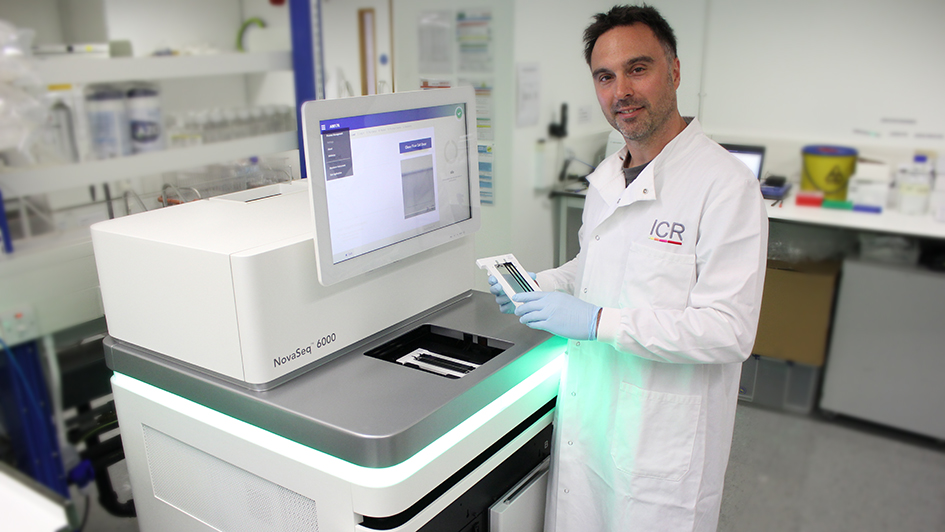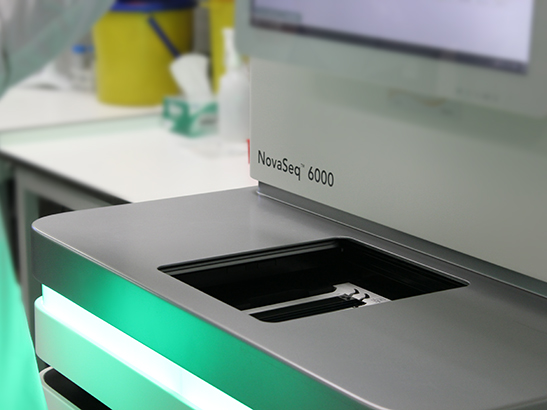
Image: Nik Matthews, Genomics Manager in the ICR's Tumour Profiling Unit with the NovaSeq sequencer.
1. To the general public, why is the NovaSeq technology exciting?
The genomics explosion is phenomenal. It took 13 years and cost $3 billion to generate the first human genome sequence, which was published back in 2003.
It now costs less than £100 to generate an equivalent amount of data and we can yield the human genome up to 240 times in one run. Or seen another way, we can now produce data equivalent to the size of the original human genome project every six minutes, which is astonishing.
2. What are the biggest improvements for cancer research that will come out of advancements in sequencing technologies?
This is a great question and hard to answer due to the nature of funding, expectation and strangely enough, knowledge. We are in an amazing time of discovery but we are still infants when it comes to understanding complex diseases such as cancer.
Machines like the NovaSeq genome sequencer have the power to start the process of helping to stratify and formally dictate treatment plans for cancer patients (as the Government's Chief Medical Officer, Professor Dame Sally Davis suggested in the Generation Genome report in July) and we want to be a part of this.
3. The field of genome sequencing is a fast moving one. What developments have most surprised you in this space?
If I gave a talk ten years ago explaining what we would be doing now I would have been laughed off stage, “a genome in ten minutes – good one Nik”. The speed, cost and robustness is staggering – I’m not sure you can say the same in almost any other scientific field – ever.
4. Do you think platforms like NovaSeq will be critical for the introduction of patient genome sequencing as part of routine healthcare?
I think the NovaSeq is the stepping stone to exactly this. I do not pretend to know the future of clinical medicine but I do see genomics playing a somewhat significant role within it.
5. Who will be using this machine at the ICR?
I’m hoping everyone because the more work we do the cheaper it all becomes. The ICR is the first institution in the UK to have this machine and we should be, and are, pushing ahead to create a long-lasting genomics programme at the ICR.
Research at the ICR is underpinned by generous contributions from our supporters. Find out more about how you can contribute to our mission to make the discoveries to defeat cancer.
6. The NovaSeq is the latest sequencing platform from Illumina…how does it differ from its predecessors?
The set-up of the NovaSeq is similar to the NextSeq as both employ cartridge-based reagents and utilise the two-channel Sequencing By Synthesis (SBS) technology. However, after this the similarities cease.
It is similar to the X-Ten and the 3000/4000 HiSeqs in that it employs ExAmp Cluster Amplification using a patterned flowcell. However, the NovaSeq’s throughput is larger than any HiSeqs on the market.
Basically, the best bits of the NextSeq have been merged with the X-Ten to create a sequencing machine that, in my opinion, makes other larger throughput machines redundant.
7. In practical terms, what are the benefits of having a faster sequencing platform with more capacity?
The main reason to get this machine was to be able to offer affordable Whole Genome Sequencing (WGS) to the ICR and our partners.
Initially, the only way to do this and compete with external companies based outside the UK was to buy X-Five or X-Ten HiSeqs, but this would have required a massive financial investment by the ICR. So, the NovaSeq idea was born.
Now the funds are recycled within the ICR and not sent to China, where lots of commercial sequencing companies are based. Believe me when I say – the NovaSeqs are the X-killers. No one will buy another X-Five or X-Ten.
8. How many bp (base pairs) of DNA do we expect to sequence a day on this machine?
Good question – billions.
To give some perspective – on the S2 flowcell, the only flowcell you can get with the NovaSeq at the moment, you can sequence, say eight whole human genomes in just 40 hours to obtain 30x coverage, a measure of how often a region of genome has been read on average. Running one DNA sample on a S2 flowcell, gives you a total coverage of 240x.
But NovaSeq can run two flowcells at the same time, so talking about sequencing in terms of per day or per hour really loses its meaning and we start talking about minutes. This is crazy as I worked on the first genome project and it took us 13 years.
9. Where do you think the field of genome/DNA sequencing will be in five years?
I think the only way forward – apart from the improvements in speed, cost reduction and robustness that will happen – is precision, specificity and sensitivity.
I think we may have to look backwards to go forwards. Look at how we treated DNA and RNA years ago to keep it as intact as possible, meaning less library preparation, if any. Perhaps direct RNA-seq to remove the bias of 1st and 2nd strand synthesis would help, and a better way of calculating concentration so we can do away with polymerase chain reaction (PCR) completely.
10. And finally, what do you enjoy most about working in this field?
I am so lucky to work with fantastic scientists and with a great team in the Tumour Profiling Unit. I see what we are doing as an adventure. Even if it is a slow methodical one I’m enjoying the ride. If you can enjoy the trip as much as the destination, you really are a lucky person.
The answers in this Q&A are the opinions of Nik Matthews, and don’t necessarily reflect the views of the ICR.
